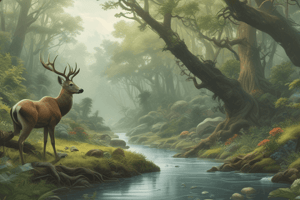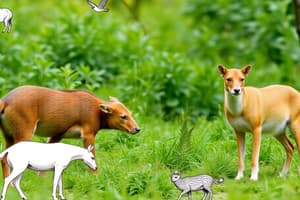Podcast
Questions and Answers
Define ecosystem.
Define ecosystem.
All the living organisms in a place and the interactions between them and their physical environment.
Define community.
Define community.
Group of organisms of different species that live in the same habitat.
What is a habitat?
What is a habitat?
A place where organisms live or shelter for the organisms.
Define population.
Define population.
Which of the following factor does not affect the population size
(Select all that apply)
Which of the following factor does not affect the population size (Select all that apply)
What is bioaccumulation?
What is bioaccumulation?
Define biomagnification.
Define biomagnification.
What is a food chain?
What is a food chain?
The basic source of energy is sunlight.
The basic source of energy is sunlight.
Which one among these is not an important fact about food chains?
Which one among these is not an important fact about food chains?
What are the trophic levels in a food chain?
What are the trophic levels in a food chain?
Define decomposers.
Define decomposers.
Movement of nutrients is cyclic but flow of energy is unidirectional and non-cyclic.
Movement of nutrients is cyclic but flow of energy is unidirectional and non-cyclic.
Which of these is NOT a type of food web?
Which of these is NOT a type of food web?
What are ecological pyramids?
What are ecological pyramids?
Which of these is NOT a type of ecological pyramid?
Which of these is NOT a type of ecological pyramid?
What does a pyramid of numbers represent?
What does a pyramid of numbers represent?
A pyramid of numbers always depict a pyramid shape.
A pyramid of numbers always depict a pyramid shape.
Flashcards
Ecosystem
Ecosystem
All the living organisms in a place and the interactions between them and their physical environment.
Community
Community
Group of organisms of different species that live in the same habitat.
Habitat
Habitat
A place where organisms live or shelter.
Population
Population
Signup and view all the flashcards
Space for Breeding
Space for Breeding
Signup and view all the flashcards
Food Availability
Food Availability
Signup and view all the flashcards
Bioaccumulation
Bioaccumulation
Signup and view all the flashcards
Biomagnification
Biomagnification
Signup and view all the flashcards
Food chain
Food chain
Signup and view all the flashcards
Producers
Producers
Signup and view all the flashcards
Consumers
Consumers
Signup and view all the flashcards
Primary consumers
Primary consumers
Signup and view all the flashcards
Secondary consumers
Secondary consumers
Signup and view all the flashcards
Tertiary consumers
Tertiary consumers
Signup and view all the flashcards
Quaternary consumers
Quaternary consumers
Signup and view all the flashcards
Decomposers
Decomposers
Signup and view all the flashcards
Food web
Food web
Signup and view all the flashcards
Producers in Food Web
Producers in Food Web
Signup and view all the flashcards
Top Predators in Food Web
Top Predators in Food Web
Signup and view all the flashcards
Pyramid of numbers
Pyramid of numbers
Signup and view all the flashcards
Pyramid of biomass
Pyramid of biomass
Signup and view all the flashcards
Pyramid of productivity
Pyramid of productivity
Signup and view all the flashcards
Bioaccumulation
Bioaccumulation
Signup and view all the flashcards
Biomagnification
Biomagnification
Signup and view all the flashcards
Extinction
Extinction
Signup and view all the flashcards
Trophic Level Disturbance
Trophic Level Disturbance
Signup and view all the flashcards
Decomposition
Decomposition
Signup and view all the flashcards
Nutrient Recycling
Nutrient Recycling
Signup and view all the flashcards
Environmental Cleaning
Environmental Cleaning
Signup and view all the flashcards
Study Notes
Ecosystems Around the World
- This study covers different ecosystems, varied habitats, bioaccumulation of toxins, biomagnification, and habitat surveys—as detailed in textbook pages 54-70.
Ecosystem Definitions
- Ecosystem: All living organisms in a place and their interactions with the physical environment.
- Community: A group of different species living in the same habitat.
- Habitat: The place where an organism lives or finds shelter.
- Population: The total number of individuals of one species living in a specific area.
Factors Affecting Populations
- Space: Availability for breeding (can lead to extinction)
- Food: Availability (overgrazing can be a factor)
- Waste Products: Toxins, insecticides, pesticides, bioaccumulation
- Disease
- Predators
- Physical Environment: Temperature shifts, water availability, pH changes (e.g., due to acid rain)
Food Chain
- The flow of energy in an ecosystem is one-way.
- A sequence of organisms through which energy flows is called a food chain.
- The basic energy source is sunlight.
- Organisms obtain energy from the organism in the level below.
Important Aspects of Food Chains
- Producers: Plants, make their own food through photosynthesis.
- Consumers: Animals, that cannot create their own food and eat plants or other animals for energy.
Trophic Levels in Food Chains
- Producers: The base of the food chain.
- Consumers:
- Primary consumers: Herbivores (eat plants)
- Secondary consumers: Primarily carnivores (eat herbivores)
- Tertiary consumers: Secondary carnivores (eat other carnivores)
- Quaternary consumers: The top predators at the highest level.
- Decomposers: Break down organic matter, returning nutrients to the ecosystem.
Example: Grazing Food Chain
- Flower (producer) → Caterpillar (consumer) → Frog (consumer) → Snake (consumer) → Owl (consumer)
Significance of Food Chains
- Understanding feeding relationships and interactions between organisms and ecosystems.
- Understanding mechanisms of energy flow and matter circulation in ecosystems.
- Understanding the movement of toxic substances and biological magnification in ecosystems.
Food Webs
- A network of interconnected food chains.
- Organisms at various trophic levels are linked by feeding connections.
Key Facts: Food Webs
- Trophic levels connect nodes. Arrows represent energy flow (prey to predator).
- Lowest trophic level are producers. Highest trophic level are top predators.
- Movement of nutrients is cyclical, energy flow is unidirectional and non-cyclic.
Examples of Food Webs
- Soil food web, aquatic food web, forest food web, grassland food web, terrestrial and aquatic ecosystem food webs.
Example: Soil Food Web
- Includes organisms like nematodes, arthropods, fungi, bacteria, protozoa, earthworms, and other decomposers along with the plants and animals they interact with.
Example: Forest Food Web
- Includes organisms like plants, goats, rabbits, mice, jackals, wild cats, owls, snakes, and kites
Example: Aquatic Food Web
- Includes organisms such as aquatic plants, fish, insects, frogs, birds, and other organisms found in aquatic ecosystems.
Significance of Food Webs
- Distinguishing and defining levels of producers and consumers.
- Understanding the foundation of ecosystems and food chains, sustaining life through nourishment and oxygen.
- Providing stability to ecosystems.
Energy Flow in Food Chains/Webs
- Energy is lost at each level of the food chain.
- Loss due to respiration (as heat), movement, finding food.
- Warm-blooded animals lose heat in waste products and maintaining body temperature.
Ecological Pyramids
- Graphical representations of the trophic structure of an ecosystem.
- Shows the feeding positions in a food chain (primary producers, herbivores, primary carnivores, etc.)
Types of Ecological Pyramids
- Pyramid of numbers: Represents the number of individuals per unit area at different trophic levels.
- Producers typically form the base—with large numbers.
- Top carnivores have the fewest numbers.
- Can be inverted (e.g., a single tree supporting many insects).
- Pyramid of biomass: Represents the biomass (mass of living matter) present per unit area of different trophic levels.
- Producers have the highest biomass at the base.
- Pyramid of productivity: Shows the flow of energy through each trophic level over a set time.
- Producers have the greatest productivity.
Decomposers
- Organisms that break down organic matter.
- Important for recycling nutrients.
- Examples include bacteria and fungi.
Breakdown of carbon and nitrogen compounds into simpler forms is a role of the decomposers in an ecosystem
Role of Decomposers
- Breaking down complex carbon and nitrogen compounds into simpler forms.
- Recycling nutrients.
- Cleaning the environment.
Disturbances in Ecosystems
- Bioaccumulation: Chemicals accumulate in organisms, potentially reaching lethal levels.
- Biomagnification: Chemical concentrations increase at higher trophic levels in a food chain.
- Extinction of species: Declining populations disrupt the balance of tropic levels, impacting some levels with excess populations while others suffer.
Studying That Suits You
Use AI to generate personalized quizzes and flashcards to suit your learning preferences.




